"Conceptual Valence Bond Theory is, similarly, a working language for describing the structures of millions and millions of molecules whose architecture chemists have determined."

 |
Molecules and The Chemical Bond by Henry A. Bent Trafford Publishing
book review by Mihir Shah
Based on the principles of Schrodinger's equation, Henry A. Bent's discourse on conceptual valence bond theory is both fascinating and thorough. Filled with extreme amounts of detail, the textbook rarely ever comes across as dull or dense. Instead, there is almost a narrative feel: The short paragraphs followed by diagrams system employed by the author makes it a resourceful tool for advanced chemistry students as well as beginners or non-science individuals who have an interest in moles and the way electrons work. In fact, this textbook would be a great supplement for college students who are currently going through their chemistry courses.
Interestingly, Bent depicts his textbook and the concepts—valence stroke diagrams and valence sphere models—therein as old wine in a new bottle. Certainly, the metaphor presents a vivid image and clarity to readers. Moreover, there is a lot of backstory or origination theory, especially when he is introducing his research on the tetrahedron. The author's findings and information is impeccable as he references numerous historical figures that played a monumental role in valence theory. For example, he referenced Edward Franklin, the father of valence theory, Walter Kohn's Nobel Lecture, as well as Mulliken. Ultimately, the succinct work of the author and his implementation of other research lends tremendous credibility to the text itself.
As far as the information in the text is considered, interested readers can expect to be enthralled by Bent's discussion on computational and conceptual valence theory, VSEPR theory, and explanation of structural, organic and inorganic chemistry in relation to valence bond theory. To make it simple and comprehensible, there are tables that separate the contrasting concepts and detailed explanations and definitions identifying those differences. For instance, Bent takes an entire page, in table form, to differentiate a cation from an anion, ionic radius, covalent bond, ionic bond, metallic bond, etc. In case the reader missed a vital piece of information, there is a summary and review at the end of each section. For those who wish to dig further into the conversation, there is a strong appendix section as well. Ultimately, the advanced chemist and anyone with an ounce of interest in valence bond theory will find this a must have book.
RECOMMENDED by the US Review